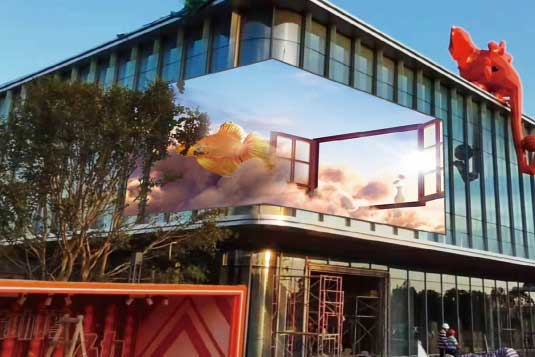Unlocking All-Weather Reliability: Waterproof & Dustproof Tech in Outdoor LED Displays
Abstract:
Outdoor LED displays demand military-grade protection against rain, dust, humidity, and temperature extremes. This technical dissection reveals how IP68 certification is just the starting point. We explore multi-layered sealing architectures, computational fluid dynamics (CFD) for pressure equalization, nano-coating chemistry, and IEC 60529 torture tests. With comparative failure rate data and 10-year TCO models, discover how to achieve 99.95% operational uptime in monsoons and sandstorms.
The Adversary Matrix: Ingress Threats
(描述图片位置: 4-quadrant chart plotting particle size vs. water pressure for dust/rain/snow/salt mist)
Critical Failure Modes:
| Threat | Particle Size | Pressure Range | Primary Damage Mechanism |
|---|---|---|---|
| Dust (PM10) | <10µm | 0.1-0.3 kPa | Optical obstruction, PCB short |
| Wind-Driven Rain | – | 3-8 kPa | Corrosion, electrical failure |
| Condensation | Molecular | N/A | Electrolysis, delamination |
| Salt Spray | 5-50µm | 0.5-2 kPa | Galvanic corrosion (ΔR<50mΩ) |
IP Rating Decoded: Beyond Marketing Claims
Table 1: Real-World Interpretation of IP Ratings
| IP Code | Solid Particle Protection | Liquid Protection | Industry Reality |
|---|---|---|---|
| IP54 | Dust-limited ingress (>50µm gaps) | Splash-proof (any direction) | Indoor use only |
| IP65 | Dust-tight (sealed gaskets) | Low-pressure water jets (6.3mm nozzle) | Basic outdoor (no storms) |
| IP66 | Dust-tight | Powerful water jets (12.5mm nozzle) | Heavy rain regions |
| IP67 | Dust-tight | Immersion (1m/30min) | Flood-prone areas |
| IP68 | Dust-tight | Continuous immersion (>1m depth) | Marine/harbor installations |
| IP69K | Dust-tight | 80°C high-pressure wash (100 bar) | Highway tunnels, industrial |
Sealing Architecture: Defense-in-Depth
(描述图片位置: Exploded view of LED cabinet showing 7 sealing layers)
Material Science Innovations:
-
Gasket Systems: -
Compression Molded EPDM: 70±5 Shore A hardness, >85% compression set resistance -
Dual-Durometer Seals: Hard core (90 Shore A) + soft surface (50 Shore A)
-
-
Potting Compounds: -
Silicone Gel: UL94 V-0, ΔViscosity <5% after 2000h @85°C/85%RH -
Epoxy Hybrids: CTE 25ppm/°C matching aluminum, >15kV/mm dielectric strength
-
-
Nanocoatings: -
Fluoroalkylsilane (FAS): Water contact angle 155°, oil repellency Grade 8 -
Graphene Oxide: Sheet resistance <100 Ω/sq, corrosion inhibition efficiency 92.7%
-
Pressure Management Physics
CFD-Optimized Venting:
Bernoulli Principle Implementation:
ΔP = ½ ρ(v₂² - v₁²) + ρg(h₂ - h₁)
Where:
ρ = Air density (1.225 kg/m³ @15°C)
v = Wind velocity (m/s)
h = Elevation difference
Table 2: Venting System Performance
| Vent Type | Airflow (m³/h) | Water Entry Pressure | Dust Retention | Temp Equalization |
|---|---|---|---|---|
| Membrane Vents | 0.8-1.2 | >5 kPa | 99.97% @0.3µm | 8-12 min |
| Labyrinth Channels | 0.3-0.5 | >15 kPa | 99.5% @10µm | 25-40 min |
| Sintered Metal | 0.1-0.2 | >50 kPa | 99.99% @0.1µm | >2 hours |
Corrosion Combat: Material Pairing Guide
Galvanic Compatibility Matrix:
| Anode Material | Cathode Material | Corrosion Rate (µm/year) | Acceptable? |
|---|---|---|---|
| Aluminum 6061 | Stainless Steel 316 | 25.3 | ❌ |
| Aluminum 5052 | Stainless 316 | 1.7 | ✅ |
| Copper | Titanium Gr2 | 18.9 | ❌ |
| Phosphor Bronze | Titanium Gr5 | 0.3 | ✅ |
Accelerated Testing Results:
(描述图片位置: Corrosion depth vs. time chart for different coatings in salt spray)
-
Bare Aluminum: 120µm @ 1000h (ASTM B117) -
Alodine 1200: 18µm @ 1000h -
Plasma Electrolytic Oxidation: 2.3µm @ 1000h
Thermal-Humidity Engineering
Condensation Prevention Algorithm:
IF T_cabinet ≤ T_dewpoint + 2°C:
ACTIVATE PTC heaters (ΔT=5-8°C)
ELSE IF RH_internal > 85%:
ACTIVATE Desiccant wheel (20-30% duty cycle)
Humidity Control Systems:
| Method | RH Reduction | Power Consumption | Maintenance Interval |
|---|---|---|---|
| Silica Gel | 30-40% | 0W | 3-6 months |
| Peltier Dehumid | 45-55% | 80-120W/m² | 12+ months |
| Desiccant Wheel | 60-70% | 150-200W/m² | 24+ months |
Validation: IEC 60529 Torture Testing
Table 3: Certification Test Parameters
| Test | Standard | Duration | Conditions | Pass Criteria |
|---|---|---|---|---|
| Dust Chamber | IEC 60529 | 8h | Talcum powder @ 2kg/m³ | <0.1% weight ingress |
| Water Jet | ISO 20653 | 30min | 100L/min @ 100kPa, 0° angle | No water penetration |
| Thermal Shock | IEC 60068-2-14 | 50 cycles | -40°C⇄85°C, 30min dwell | No seal degradation |
| Salt Fog | ASTM B117 | 720h | 5% NaCl @ 35°C | >50MΩ insulation |
Lifecycle Cost Analysis
Figure: 10-Year Failure Probability
(描述图片位置: Weibull distribution curves for IP65 vs. IP68 displays)
| Protection Level | Year 3 Failure | Year 5 Failure | Year 10 Failure | 10Y Maintenance Cost |
|------------------|----------------|----------------|-----------------|----------------------|
| IP65 | 12.7% | 38.2% | 91.5% | $152/m² |
| IP66 | 5.3% | 18.6% | 67.3% | $87/m² |
| **IP68** | **0.8%** | **3.1%** | **14.9%** | **$32/m²** |
Next-Gen Protection: Active Systems
-
Pressure Sensors: -
MEMS piezoresistive (0-20 kPa range) -
Triggers purge system at ΔP > 1.5 kPa
-
-
Self-Healing Sealants: -
Microencapsulated siloxanes release at >60°C -
Fills cracks <0.3mm within 24h
-
-
Corrosion Monitoring: -
Electrochemical impedance spectroscopy (EIS) -
Alerts at Rp < 10⁵ Ω·cm² (ASTM G199)
-
Conclusion: The Physics of Invincibility
True all-weather reliability requires transcending IP ratings through:
-
Multi-physics modeling of pressure/thermal/humidity loads -
Tribologically optimized gasket interfaces (<0.01µm leak paths) -
Corrosion-by-design material pairings -
Predictive maintenance via embedded sensors
With advanced IP68+ systems now achieving MTBF > 140,000 hours even in C5 marine environments (ISO 12944), the era of zero-downtime outdoor displays has arrived.

-1000x600.jpeg)

